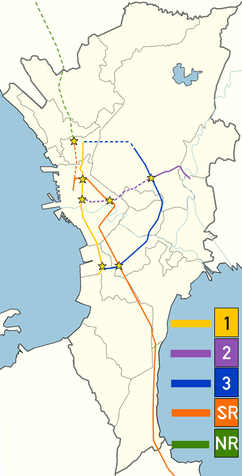Strong Republic Transit System
.jpg)


The Strong Republic Transit System was launched to integrate the various rail lines providing public transport in Manila in the Philippines. The program was initiated by former president Gloria Macapagal-Arroyo on June 14, 2003. It aimed to provide a "reliable, seamless and integrated mass transit system that would be at par with international standards" through the unification of already-existing rail infrastructure under one transit system and fare structure. The Manila Light Rail Transit System (LRT-1 and LRT-2), the Manila Metro Rail Transit System (MRT-3) and the Philippine National Railways (PNR) Northrail and Southrail lines were covered by the SRTS project.[1] The project has not been mentioned by the Benigno Aquino III and Rodrigo Duterte administrations, which currently concentrates on the extensions of LRT-1 and LRT-2[2] and the construction of MRT-7, although his administration may continue the stalled Northrail project in a reconfigured way.[3]
Links
The SRTS project provided for seven "links", i.e. interchange stations where commuters would be able to seamlessly transfer from one line to the other. When the program was initiated four links were in use. The Santa Mesa and Recto Link were added in April 2004, when the already under construction LRT–2 became fully operational. The Northrail project has been cancelled in September 2012, as a result the Caloocan Link is missing. The proposed extension of Southrail services to Caloocan, which was part of SRTS, was not executed either. The closing of the loop has as of 2015 almost been completed by extending LRT–1 with five new stations, unlike originally outlined by the plan. LRT–1 would require one more station to connect LRT-1 with MRT-2. In order of operation the following links have been realized (color coding has since been changed):
| Link | Lines and stations | |||
|---|---|---|---|---|
| Blumentritt Link | LRT–1 | Blumentritt | PNR Southrail | Blumentritt |
| Pasay Link | LRT–1 | EDSA | MRT-3 | Taft Avenue |
| Magallanes Link | PNR Southrail | EDSA | MRT-3 | Magallanes |
| Cubao Link | LRT–2 | Araneta Center-Cubao | MRT-3 | Araneta Center-Cubao |
| Santa Mesa Link | LRT–2 | Pureza | PNR Southrail | Santa Mesa |
| Recto Link | LRT–2 | Recto | LRT-1 | Doroteo Jose |
| Caloocan Link (not in use) | PNR Southrail | Caloocan | PNR Northrail | Caloocan |
Fare integration
The project aimed to unify fare systems on the lines through the use of contactless smart cards, similar to the Octopus card in Hong Kong and the EZ-Link card in Singapore. The integrated system has not been implemented, as the project was dropped. A weekly ticket which is valid on LRT-1, LRT-2 and MRT-3 lines has been introduced in 2004 though. For ₱ 250 one can make an unlimited number of rides per day on LRT-1, LRT-2, and MRT-3 lines during one calendar week with the so-called Flash Pass Card.[4]
See also
- List of rail transit stations in the Greater Manila Area
- Manila Light Rail Transit System
- Manila Metro Rail Transit System (MRT-3)
- Philippine National Railways
- PNR Metro South Commuter (earlier names: Metro South Commuter, Orange Line, Metrotren, Commuter Express or Commex)
References
- ↑ The Strong Republic Transit System, www.lrta.gov.ph (web.archive.org), February 3, 2004
- ↑ Calonzo, Andreo and Legaspi, Amita O. (2012) "PNoy wants LRT 1 extension project finished by 2015", GMA News, Online news by Region. Retrieved March 27.
- ↑ China open to reconfiguring NorthRail project, says Roxas, Philippine Daily Inquirer, September 2, 2011
- ↑ Flash Pass Ticketing System, www.lrta.gov.ph (web.archive.org), June 5, 2004